|
|
Post by agile on Feb 24, 2012 11:21:31 GMT 12
The deputy Chairman A.E. Rudder regarded a company run by three other airlines on behalf of three governments as an administrative nightmare. Surely it would have been worse without him, as the company would have been 'Rudderless'. ;D Seriously though, oh boy am I going to love this thread! |
|
|
|
Post by Peter Lewis on Feb 25, 2012 6:42:11 GMT 12
At the conclusion of hostilities in 1945, TEAL was operating just the two pre-war Empire flying boats. Plans for expansion and re-equipment were formulated. The operations side of the airline favoured the DC-4, which was already in use for trans-Pacific flights by Pan American. However, political pressure was brought to bear to buy British aircraft, and in particular, British flying boats. The Short Solent was then selected, but as this type was still some four years away from service the British Ministry of Supply arranged for TEAL to lease three (later increased to four) Short S.25 Sandringham of the 'Tasman' class as an interim aircraft type. The Sandringham was a civil conversion of the military Short Sunderland Mk.III. The conversion included replacement of the Bristol Pegasus engines used in the Mk.III with P&W R1830 Twin Wasp engines as used in the Sunderland Mk.V, and the TEAL Sandringhams were fitted with seating for 30 passengers whereas the Empire boats had seated 19. The first TEAL Sandringham had been built by Shorts at Rochester in 1944 and had served with the RAF as ML761 before being converted to civil status at Belfast in 1946. After some test flights with BOAC at Poole, it was registered as ZK-AMB on the 5th July 1947, named ‘Tasman’, and departed for New Zealand under the command of Captain Travers, a BOAC employee. Command changed to Captain Peter Jury at Sydney for the trans-Tasman leg to Auckland. TEAL commenced commercial service with the Sandringhams in August 1947, and I think that the following photos were taken around that time. ZK-AMB alighting on to the Waitemata Harbour Taxiing in to the Auckland passenger terminal Taxiing in to the Auckland passenger terminal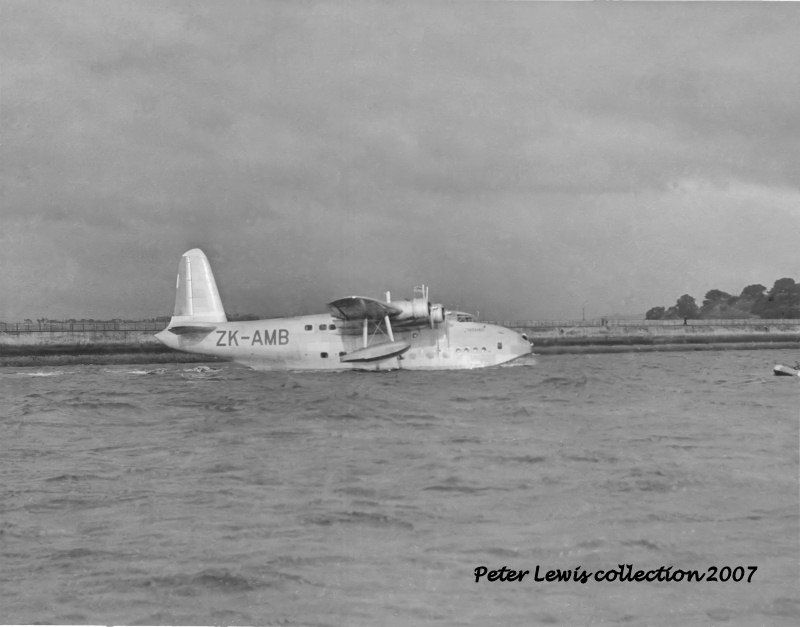 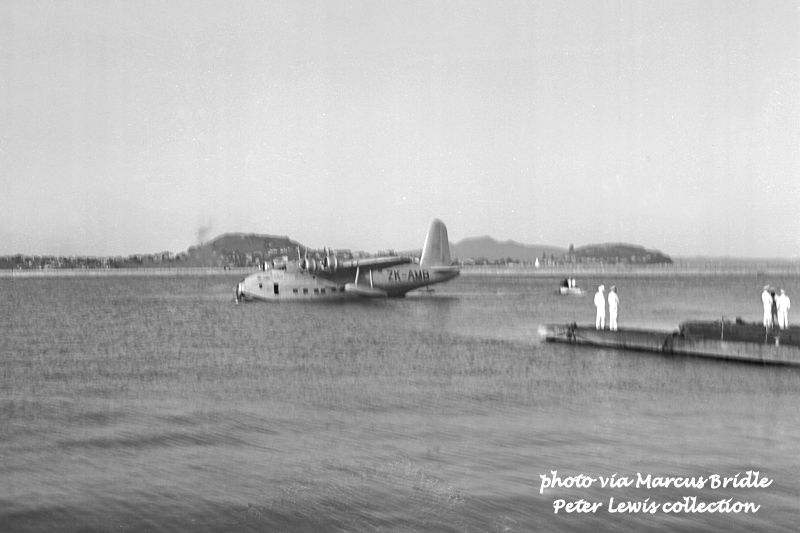 On the Mechanics Bay braby On the Mechanics Bay braby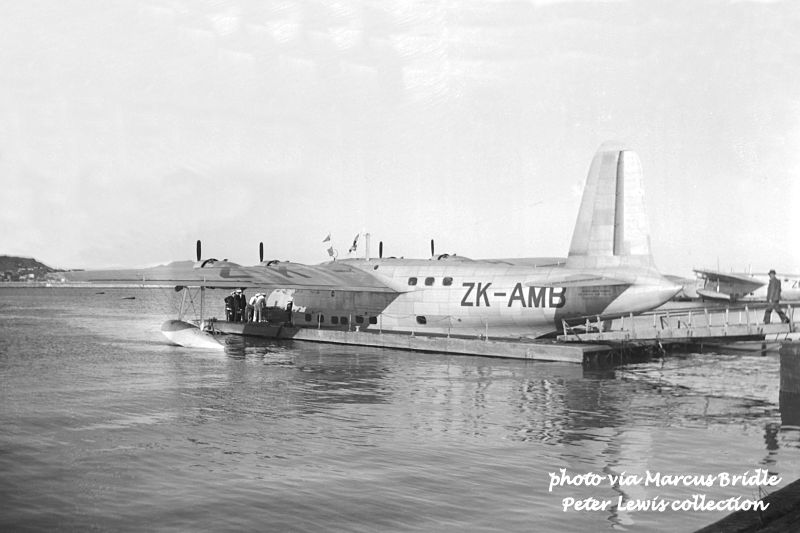 Note the security - 1940s police constable. Empire ZK-AMA and possibly ZK-AMC moored out Note the security - 1940s police constable. Empire ZK-AMA and possibly ZK-AMC moored out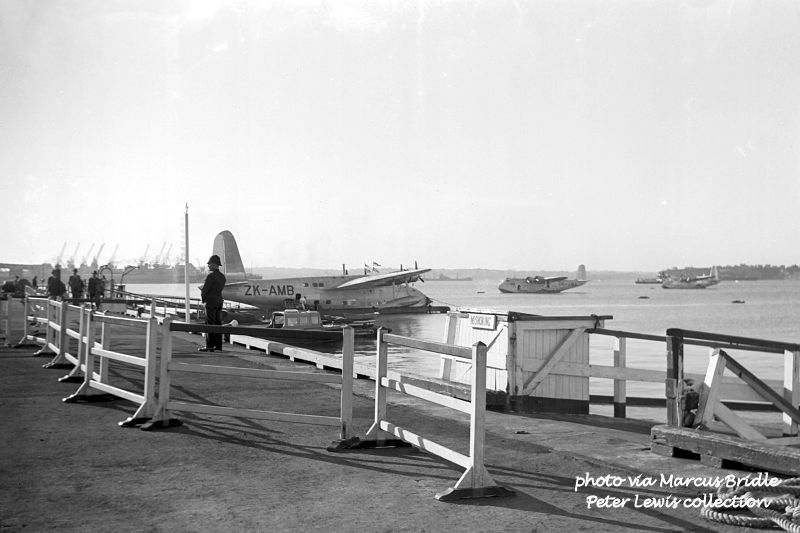 Departing Auckland Departing Auckland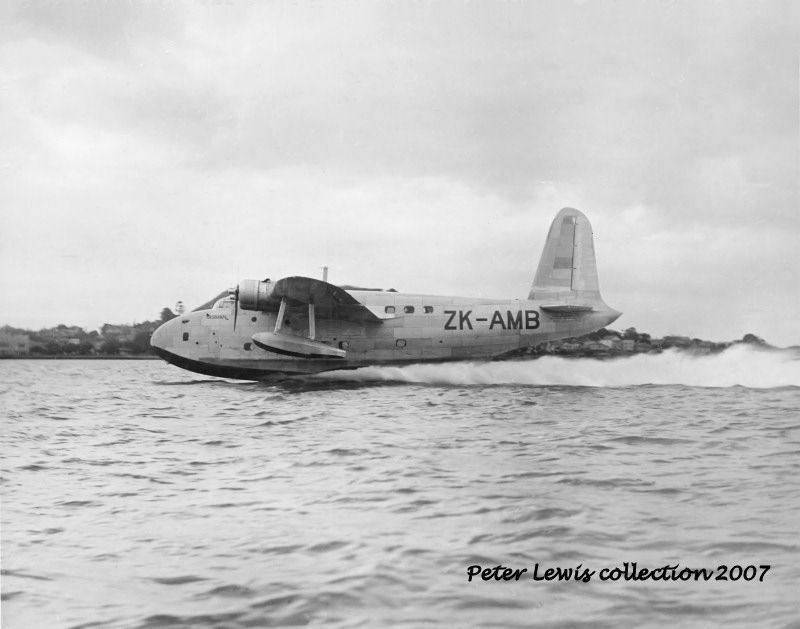 As the Sandringham engine installation had been tested in the colder weathers of the Atlantic, it was soon found that the warmer climate of the South Pacific provided inadequate engine cooling during trans-Tasman operations. After a number of more minor engine failures, a near disaster with Sandringham ZK-AME on 3rd December 1947 forced withdrawal of the type from TEAL service in February 1948 until Chief Engineer George Bolt identified the problem and additional cooling baffles had been installed. DC-4 aircraft were hired from Australia to maintain services while the Sandringham problems were solved. Re-entering operations in June that year, ZK-AMB continued in service until the long-awaited Solents appeared in late 1949. Note that the New Zealand flag has now been added to the fin ZK-AMC 'under escort'. The Devonport Royal New Zealand Navy base is in the background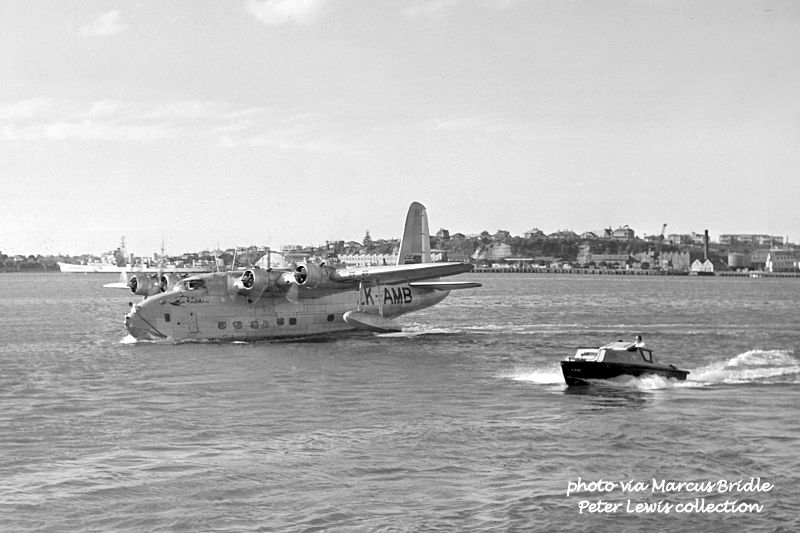 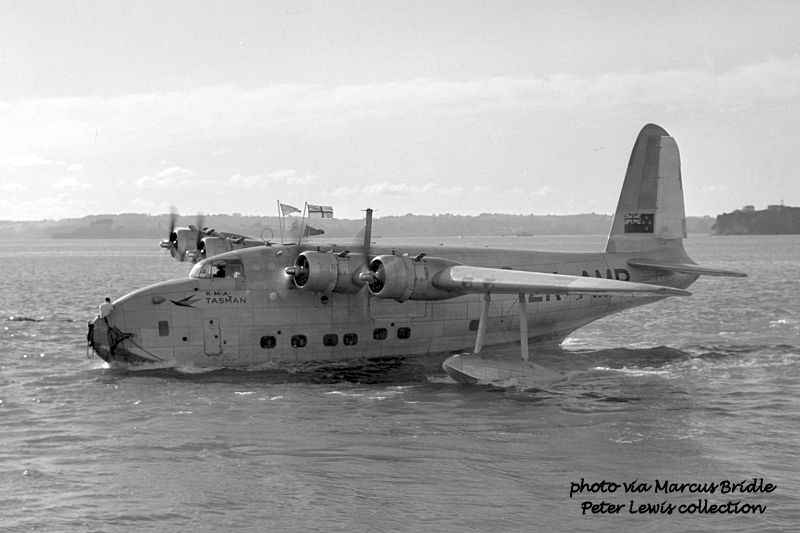 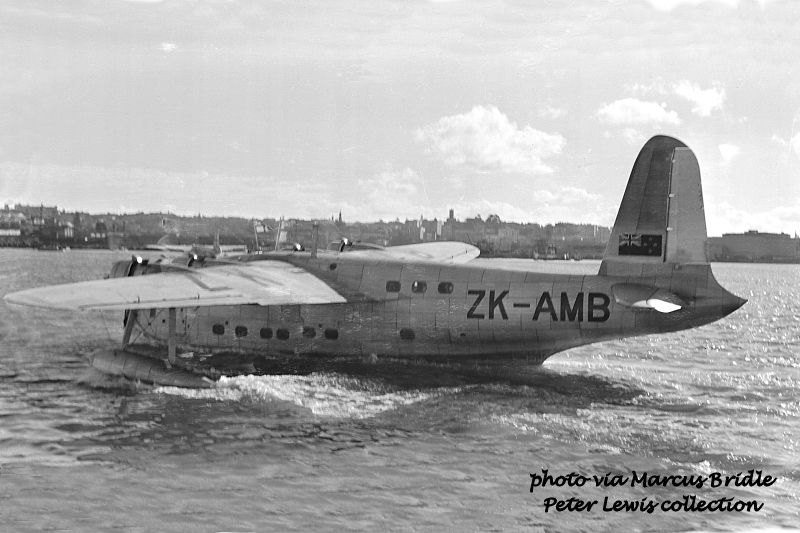 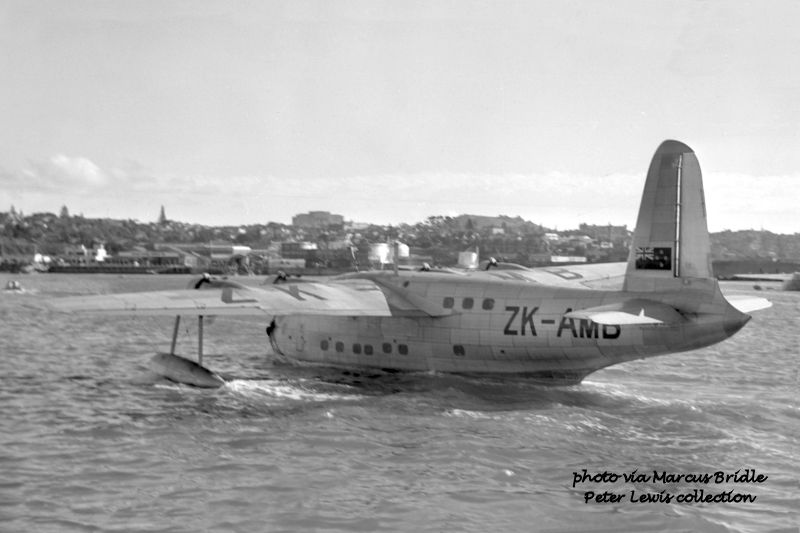 On the Hobsonville buoy On the Hobsonville buoy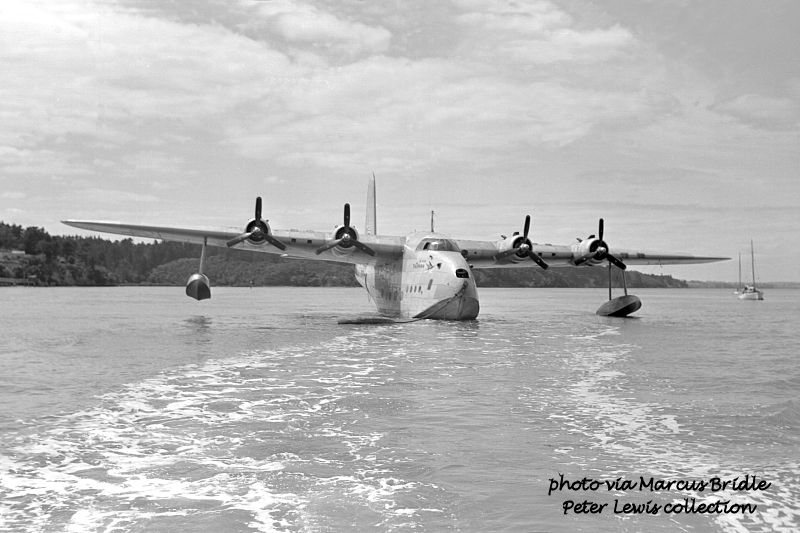 Under maintenance at Hobsonville Under maintenance at Hobsonville 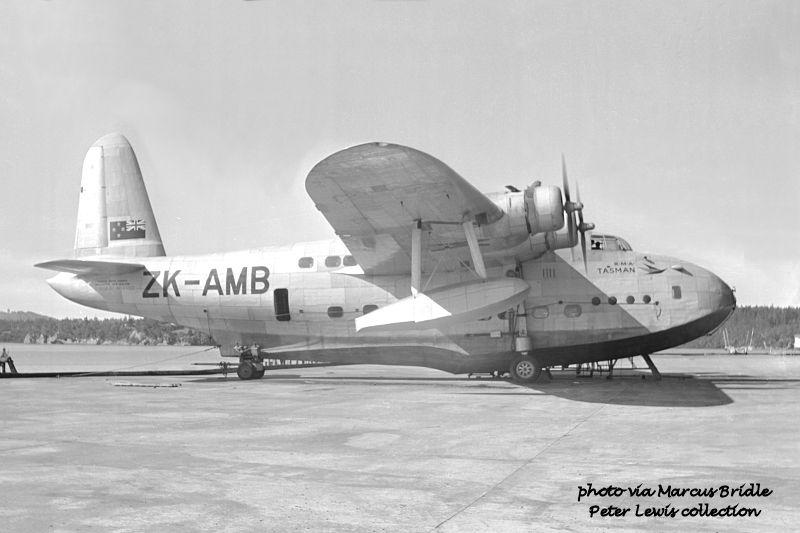 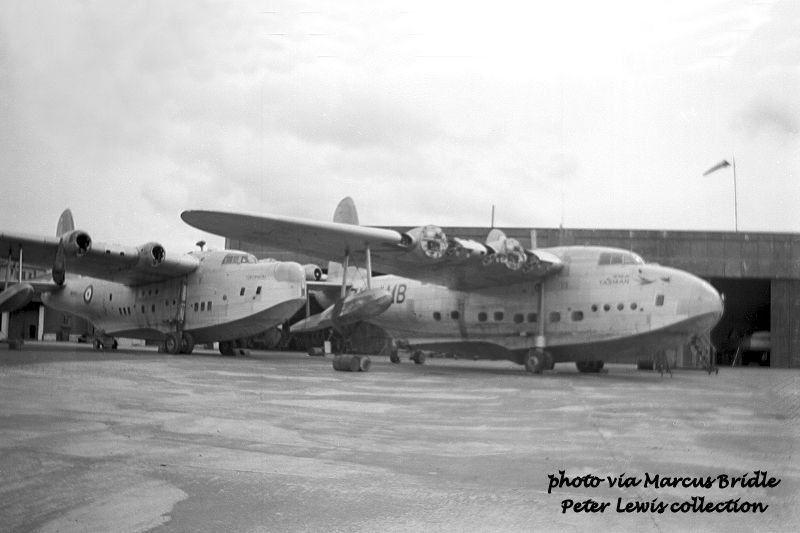 Resting at Mechanics Bay Resting at Mechanics Bay Finally withdrawn in December 1949, ZK-AMB was stored at Hobsonville until the MOS could arrange disposal. 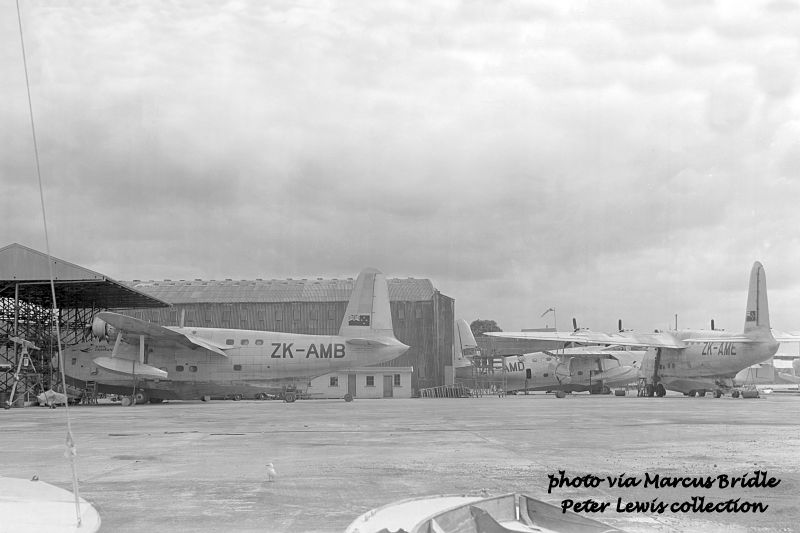  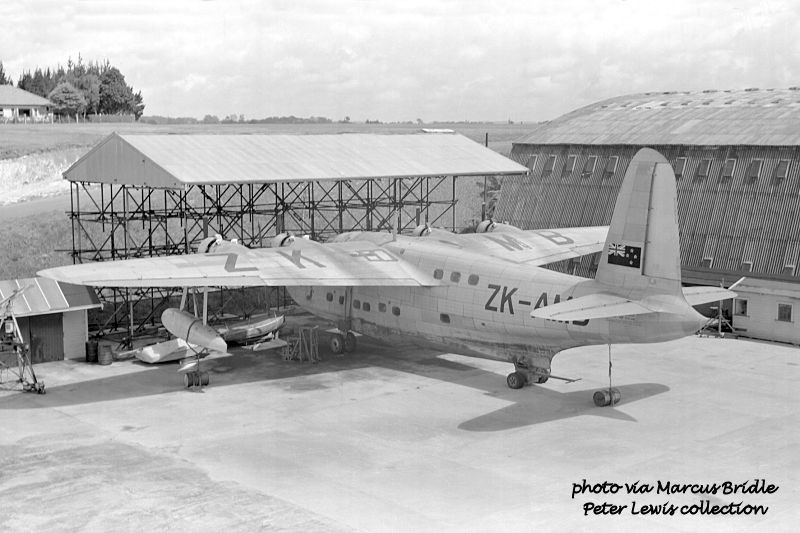 Qantas Empire Airway bought the aircraft on 18th July 1950, and ZK-AMB became VH-EBW on the 24th. The Sandringham appears to have been based at Rose Bay, Sydney, and used on Qantas’ Pacific Island services. Its end came when it struck a coral reef while taxiing in the harbour at Port Vila, New Hebrides (now Vanuatu), 10Jun51. The hull was punctured in several places and the aircraft slowly submerged while the passengers and crew evacuated. SOC 19Jul51. Wreck later scuttled in the harbor, and is now a well-known diving attraction. 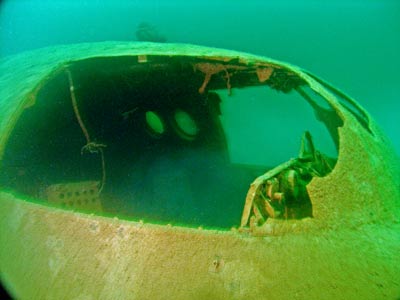 See www.michaelmcfadyenscuba.info/viewpage.php?page_id=47next: ZK-AMD |
|
|
|
Post by kiwithrottlejockey on Feb 25, 2012 20:43:01 GMT 12
ex- ML761 - SH30C - ZK-AMB - VH-EBW .... the end:   |
|
|
|
Post by Peter Lewis on Feb 26, 2012 16:04:40 GMT 12
Golly, that'd put a bit of a crimp in your day.
Looks like it needed a bit more than Bruce with his can of WD40 and roll of duct tape for that repair
|
|
|
|
Post by kevsmith on Feb 26, 2012 23:08:59 GMT 12
Re the scrapping of the boats near Panmure, my memory is that they were dismantled at Point England on the Tamaki River mud flats there and at one stage after the wings were removed the fuselages were shored up with timber so that they were essentially upright. My Dad knew the scrap dealer whose name I always remembered was McDermott. One day we visited the site and climbed up into the fuselage of one (were there two being scrapped there at the same time?) and being only a small boy of about 8 or so, I was petrified at the groaning as the fuselage moved under our weight. I couldn’t get out quick enough back down onto the Tamaki mud. McDermott also scrapped many of the Dauntless aircraft somewhere in the Penrose/Onehunga area which we also visited at some time. I also remember going on board the boat that was on shore at Mission Bay, but strangely enough the photo I have seen of that boat does not totally equate to my memory of some 60 years ago.
|
|
|
|
Post by Peter Lewis on Feb 28, 2012 10:08:37 GMT 12
Thanks for the reminiscence kev, that's what we are looking for here.
Just the one Empire boat was scrapped at Panmure, as ZK-AMA was scrapped on-site at Mission Bay. The only other TEAL Short boat that was scrapped in NZ was the fire-damaged Solent ZK-AMM in 1955 - the rest were all sold off to overseas buyers.
|
|
|
|
Post by shorty on Feb 28, 2012 11:58:12 GMT 12
Not quite, ZK-AMQ ( the sole Mk III Solent) was broken up at Mechanics Bay around 57/58. As an Intermediate school kid I climbed through it at the time and liberated some small items.
|
|
|
|
Post by Peter Lewis on Feb 28, 2012 18:49:55 GMT 12
Yes you are quite right Shorty.
Just seeing if anyone else was reading this listing eh.
|
|
|
|
Post by Peter Lewis on Feb 28, 2012 18:51:18 GMT 12
The second Short S.25 Sandringham 'Tasman' class Sunderland conversion for TEAL had been built by Shorts at Rochester as a Sunderland Mk.III c/n SH.1173 in 1944 and was taken on charge by the RAF as NJ255. Apparently this Mk.III was converted to a Mk.V (P & W power) during its military service. The aircraft was returned to Shorts in 1946 for conversion to civil status at Belfast, and emerged as a 30-passenger Sandringham with the new c/n SH.32C for the UK Ministry of Supply. Leased to TEAL, the aircraft was registered ZK-AMD on 5Jul1946, and bore the name 'Australia' . Arriving in New Zealand at the end of the delivery flight on 5Aug1946, it entered commercial service on the 26th. The following photos appear to have been taken early in its operational life: ZK-AMD moored out on the Hobsonville buoy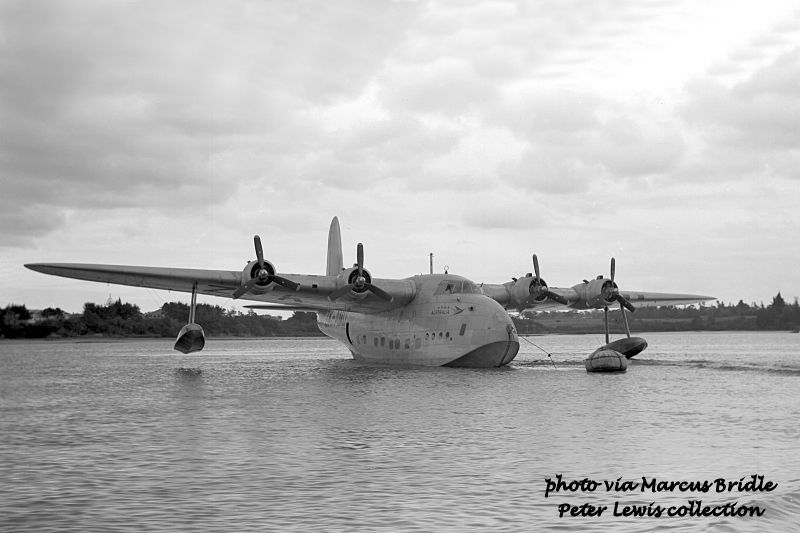 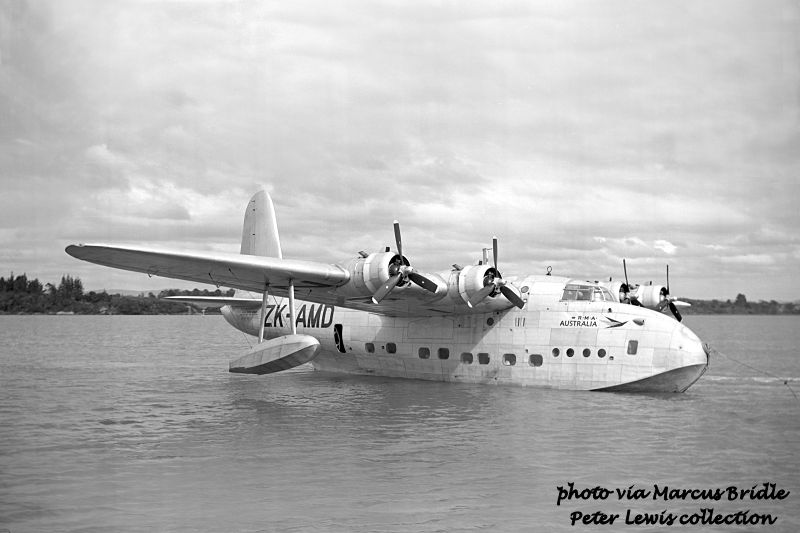 At TEAL's Mechanics Bay terminal, the service launch bears the name 'Tasmanair' At TEAL's Mechanics Bay terminal, the service launch bears the name 'Tasmanair'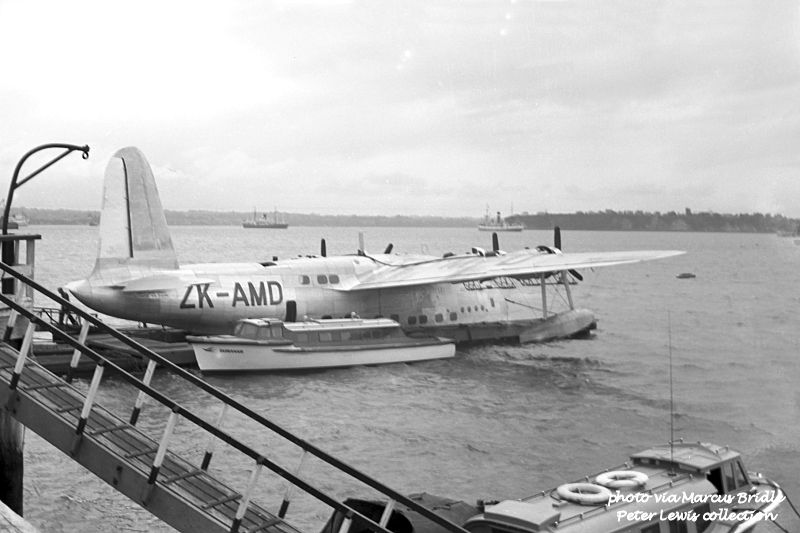 Taxiing to the takeoff point on the Waitemata Harbour Taxiing to the takeoff point on the Waitemata Harbour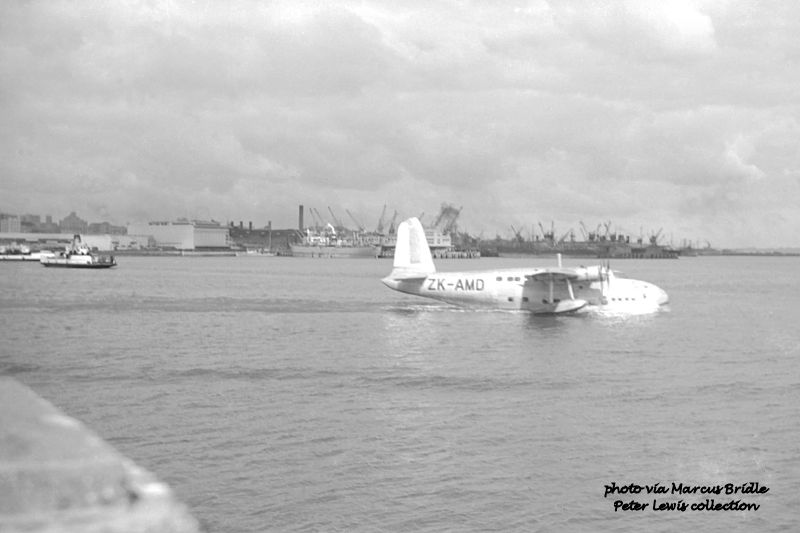 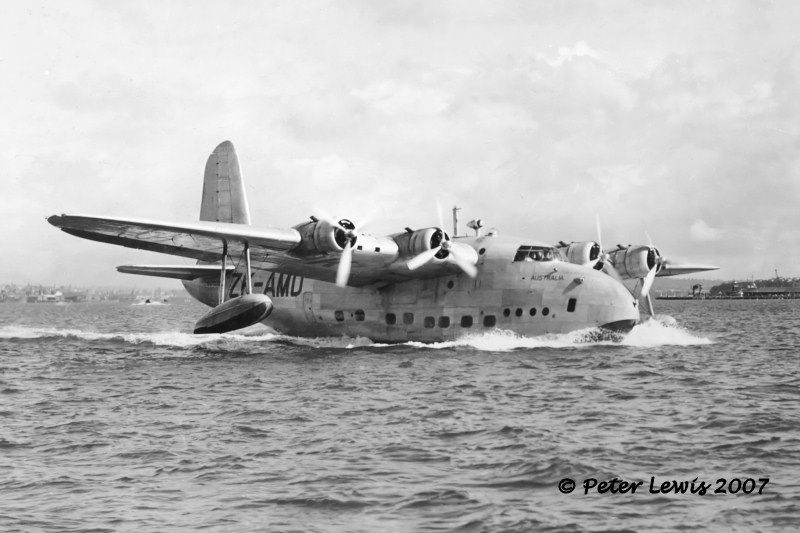 On the run, Waitemata Harbour On the run, Waitemata Harbour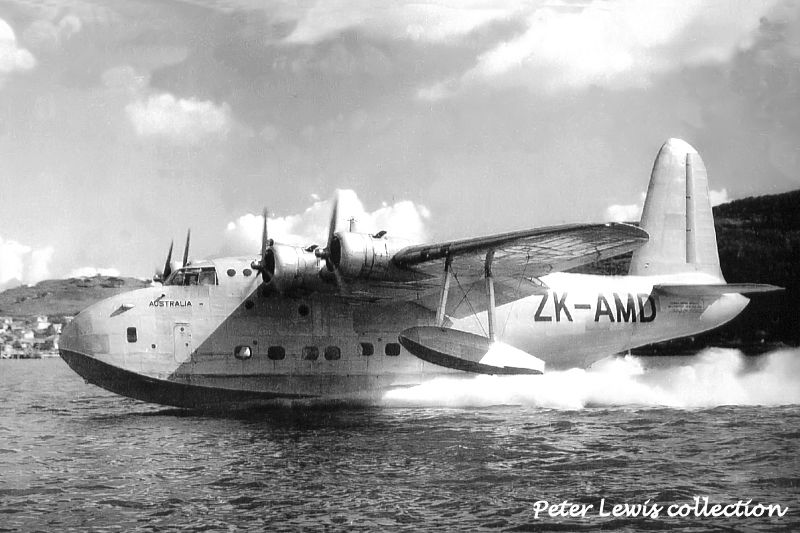 Moored on the Mechanics Bay buoy Moored on the Mechanics Bay buoy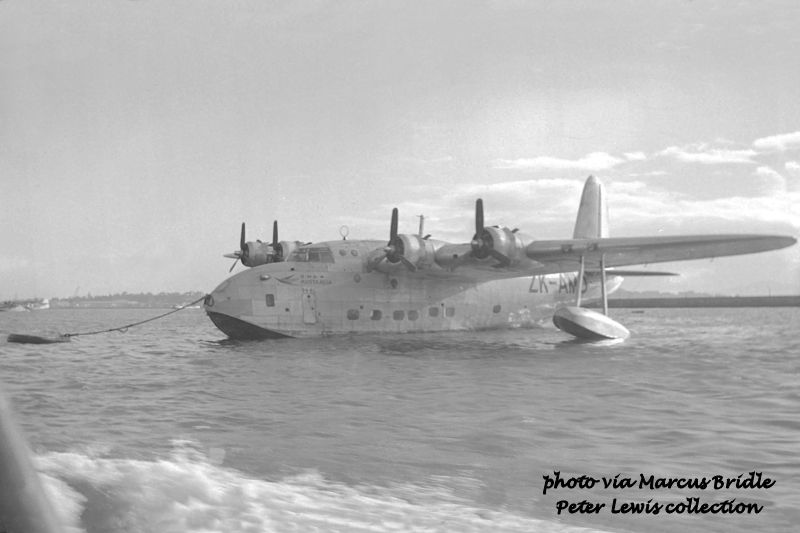 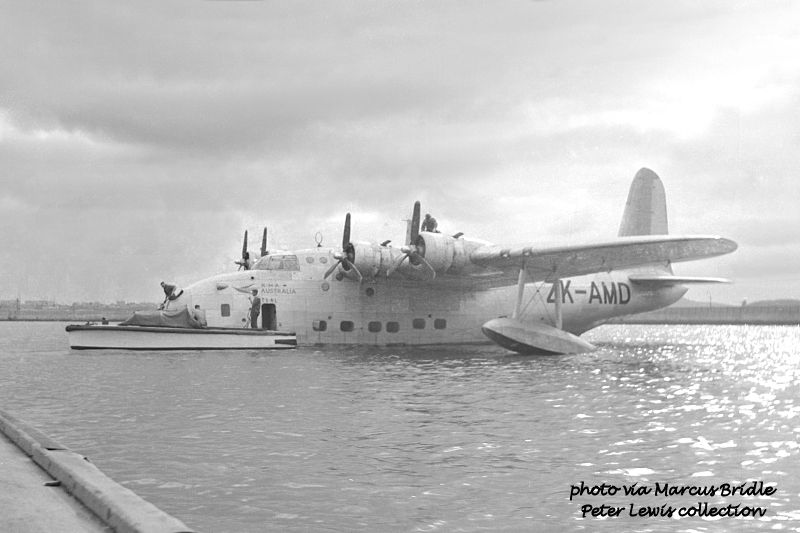 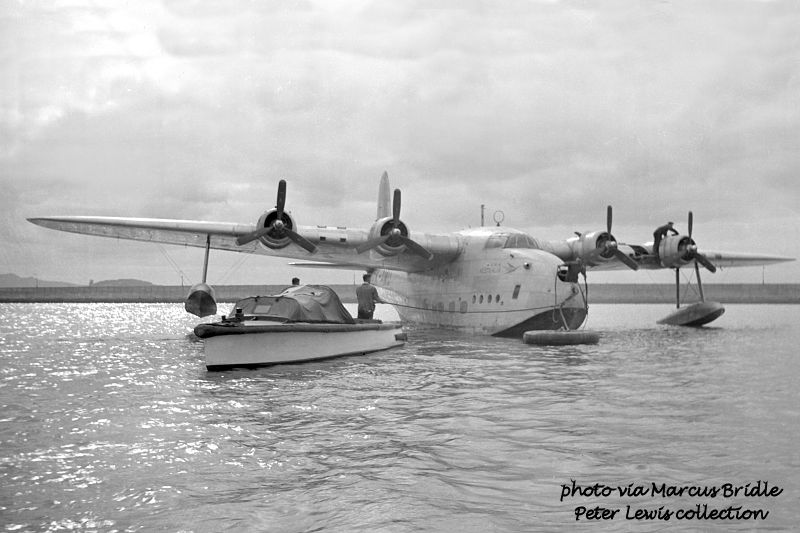 ZK-AMD appeared in Shorts advertising around that time ZK-AMD appeared in Shorts advertising around that time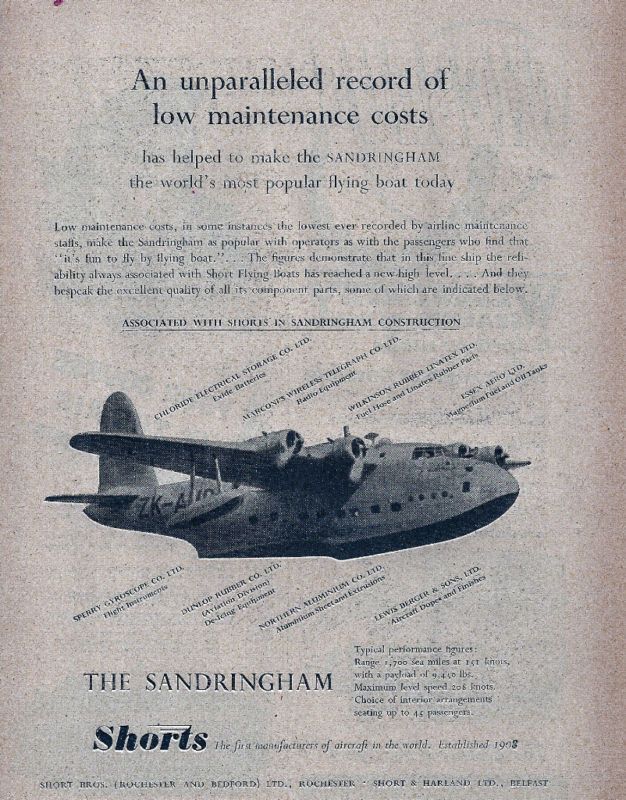 ZK-AMD was also involved in the engine overheating rectification program that affected TEAL's Sandringham fleet, being taken out of service from late February to mid-Jane 1948. Re-entering service after modifications to the engine cooling system, ZK-AMD also carried the New Zealand flag on its fin during its later life. Moored at Hobsonville during maintenance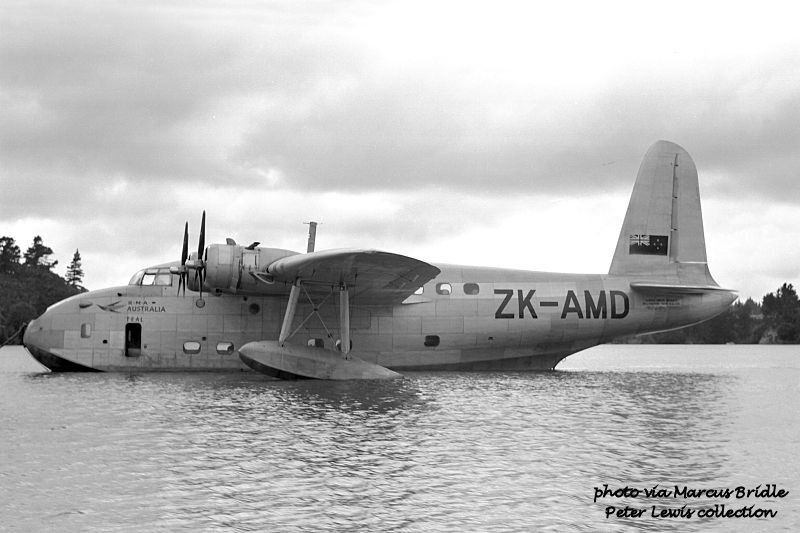 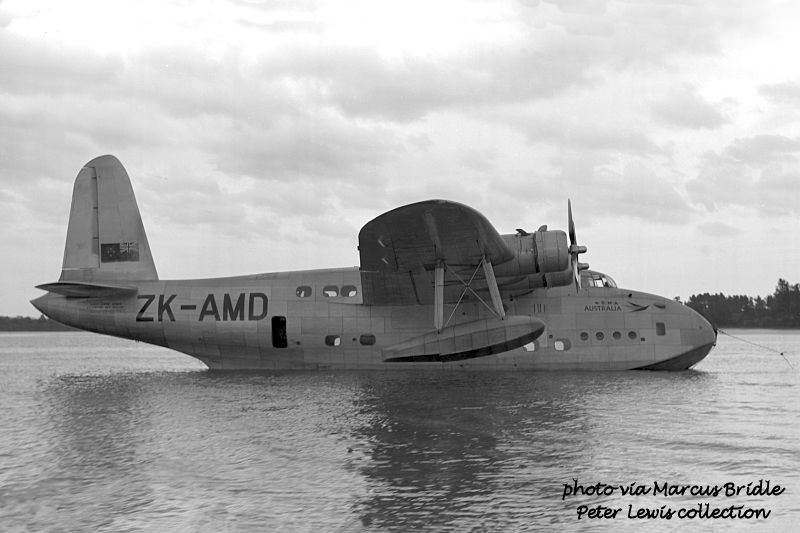  On the hard at Hobsonville On the hard at Hobsonville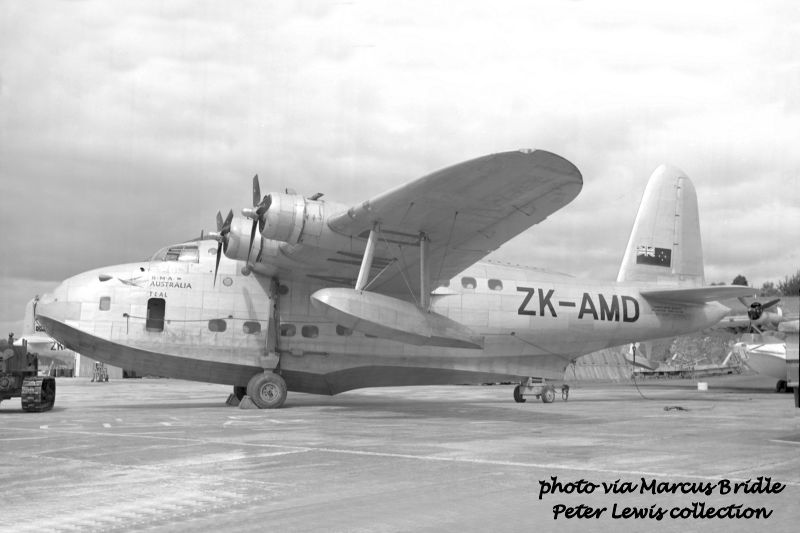 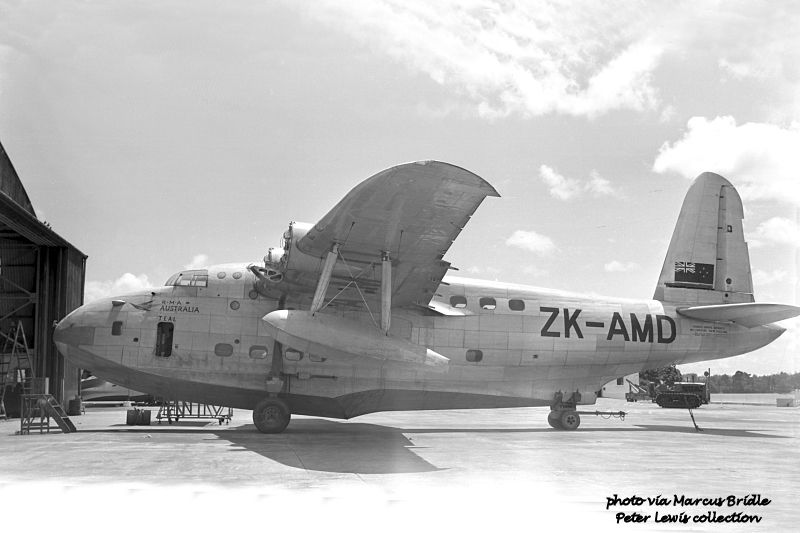 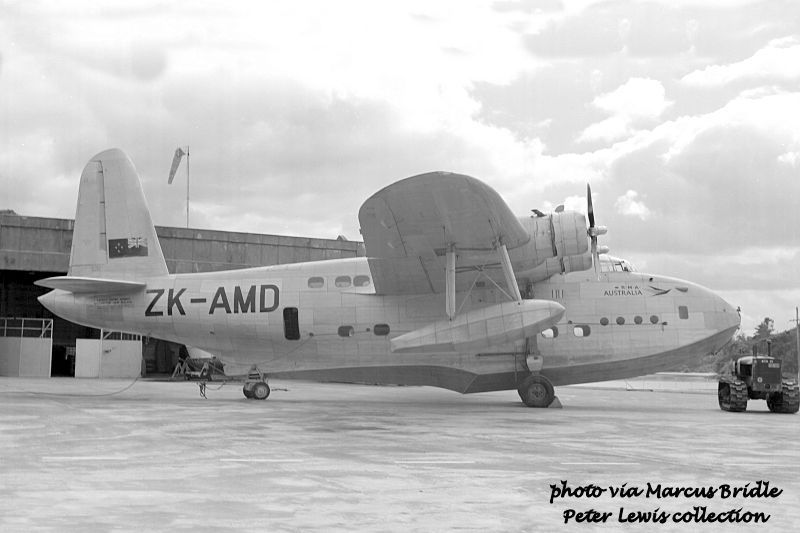 At the Mechanics Bay passenger terminal At the Mechanics Bay passenger terminal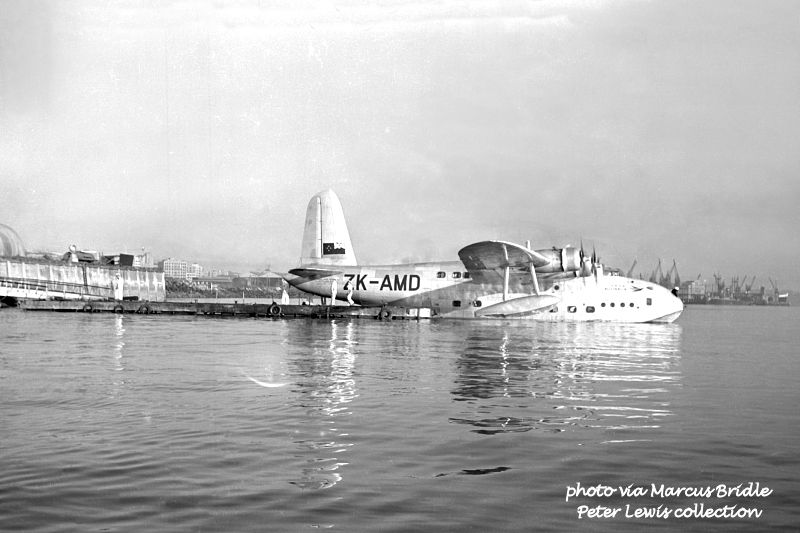 A nice airborne shot, ZK-AMD over the Waitemata A nice airborne shot, ZK-AMD over the Waitemata On the arrival of the Solent boats, ZK-AMD flew its final TEAL Service in December 1949, and was then stored at Hobsonville awaiting sale. At this time it had clocked up 4409hrs in civil and military service. Qantas Empire Airways Ltd., Sydney, Australia were the buyers of this aircraft. They took possessiom in April 1950, and ZK-AMD became VH-EBX on the 24th. Apparently used mostly on the Lord Howe Island service, VH-EBX carried the name 'Pacific Chieftain' durinng its Australian life. Ownership passed to Ansett Airways Pty. Ltd. (operating as Ansett Flying Boat Services) in December 1954, and the aircraft was re-registered as VH-BRE on the 22nd of that month. VH-BRE in Ansett colours at Rose Bay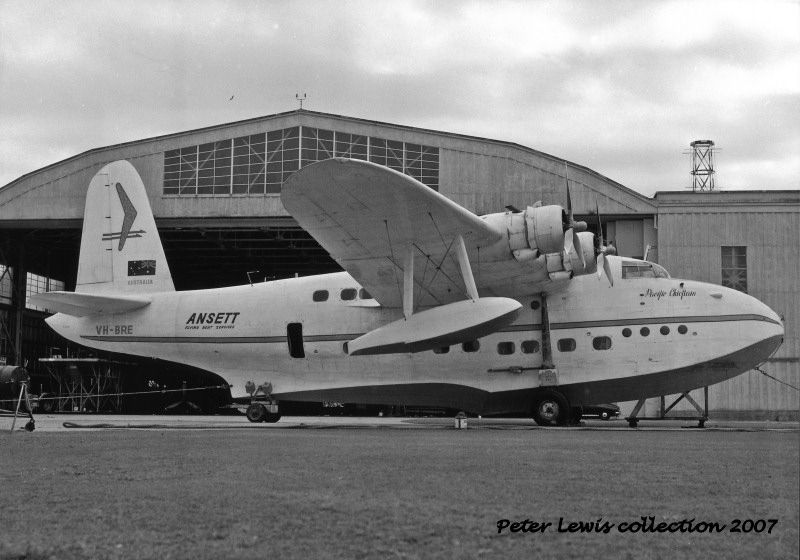 As well as operating on the Ansett Norfolk Island run, VH-BRE carried out some charter work, including charter tourist flights to New Zealand in the mid-1950s, and a lease back to TEAL from 18Sep1958 to the 25Sep1958 to cover for maintenance on TEAL's last Solent, ZK-AMO on the Coral Route over that period. The end came for this old boat at Norfolk Island in 1963. During an overnight storm on the 3rd July, VH-BRE broke its moorings and was washed ashore, damaging a wingtip float. It was towed back out to the mooring the next day, and trimmed so the opposing float was in the water. However, a further storm on the night of the 4th July destroyed that float also, and the aircraft was partially submerged. The resultant damage was such that the aircraft was deemed unrepairable. Despite attempts by the Islanders to retain the fuselage as a museum piece, the airframe was stripped of useful items, towed out to sea and sunk in December 1963. I cannot resist linking to this aussieairliners photo of the end of this Sandringham, 4th July 1963 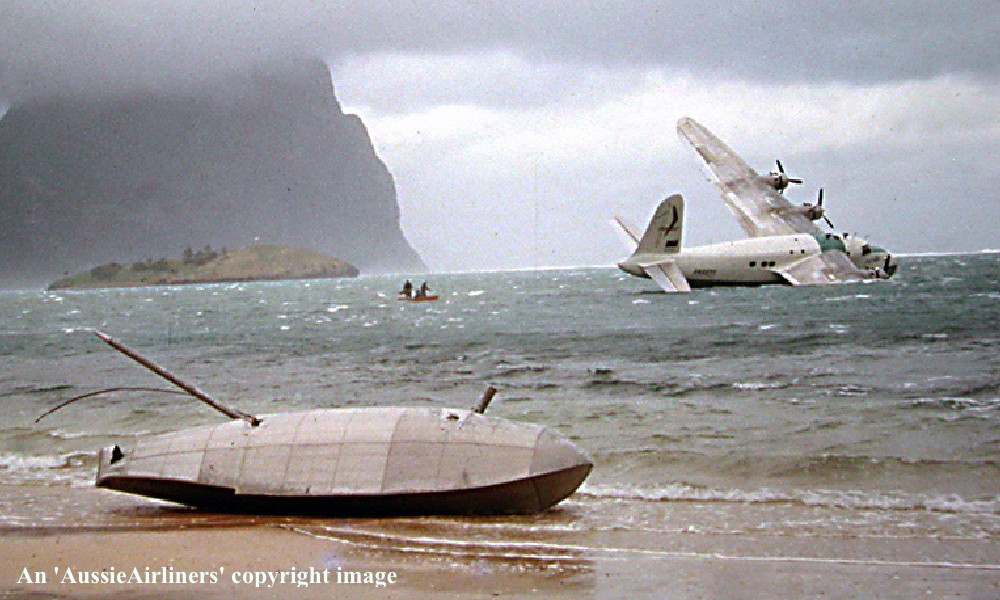 Next: ZK-AME |
|
|
|
Post by pilotpotters on Feb 28, 2012 20:34:38 GMT 12
Thats an amazing collection of photographs Peter. Are there any of the big boats still flying in the world?. I was lucky once to get up front in the Solent at Motat. I had to do an essay for a varcity paper once so chose to do the flying boats on the Coral Route. About the only time I ever enjoyed writting an essay.
Thanks for the pictures.
Potters
|
|
|
|
Post by Peter Lewis on Feb 28, 2012 21:10:11 GMT 12
Apart from the vague possibility of one or more of the Martin Mars firebombers in the USA, I do not know of any four-engined flying boats that are currently airworthy.
The only Short-built example that could reasonably still be made operational is the ex RNZAF Sunderland/Sandringham conversion now owned by Kermit Weeks and sitting in the USA. This served in the UK as ML814, in New Zealand as NZ4108, then went to Australia to become VH-BRF with Ansett in 1963. When the Lord Howe Island service finished in 1974 it was sold into the Antillies as N185J, became G-BJHS with Edward Hulton and then flew to the USA in 1993 as N185J. It has since been grounded, but with the application of money and sweat could fly again.
I was very fortunate to experience a brief flight at Hobsonville in Sunderland NZ4115 while an ATC cadet.
|
|
|
|
Post by hairy on Feb 28, 2012 22:02:43 GMT 12
|
|
|
|
Post by Bruce on Feb 29, 2012 20:45:58 GMT 12
Just found this really interesting silent film from the late 1940s / early 1950s. COLOUR footage of Sandringham boats is briefly visible at 11:07 approx. Lots of other good stuff in the film too, but that would be off thread!
|
|
|
|
Post by Peter Lewis on Mar 1, 2012 7:07:30 GMT 12
Marcus, I knew when I wrote the response that some smart person would dredge up something to prove me wrong. That's why I phrased it that way.
Bruce, I wonder why they made a silent movie that late in the century. Even in NZ at that time they had the technology for sound.
|
|
|
|
Post by Peter Lewis on Mar 1, 2012 7:10:05 GMT 12
The third Short S.25 Sandringham 'Tasman' class Sunderland conversion for TEAL had been built by Shorts at Belfast as a Sunderland Mk.III and was taken on charge by the RAF as NJ179 on 12Jun1944. After a period of operational service the aircraft was returned to Shorts for conversion to civil status at Belfast in 1946, and emerged as a 30-passenger P&W engined Sandringham with the new c/n SH.33C for the UK Ministry of Supply. Leased to TEAL, the aircraft was registered ZK-AME on 25Jul1946, and bore the name 'New Zealand'. Arriving in New Zealand at the end of the delivery flight on 4Sep1946, it entered commercial service on the 17th. ZK-AME on the Waitemata Harbour 24Oct1946 in early livery. Note the absence of 'RMA' above the name 'New Zealand'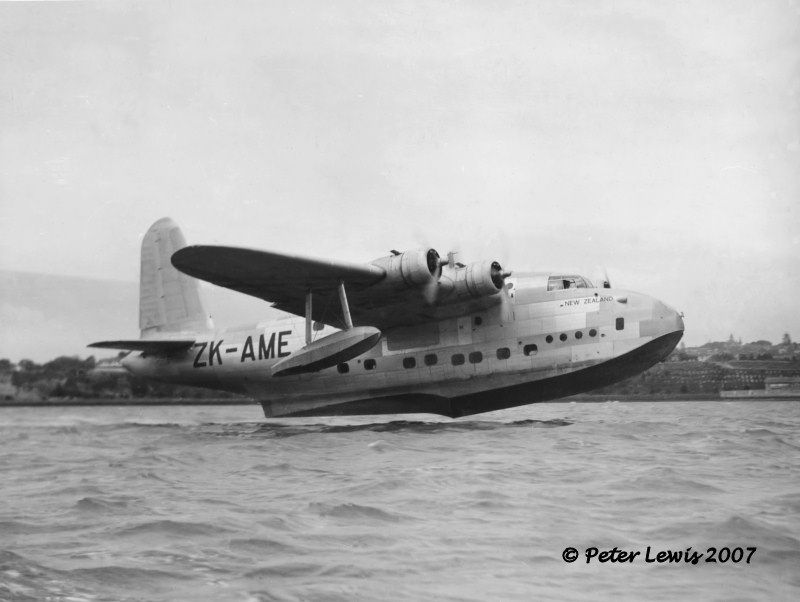 ZK-AME departed Rose Bay, Sydney, on a regular scheduled flight to Auckland at 5.25am on 3Dec1947. She carried 29 passengers (one short of a full load) and six crew, Captain Ian Patterson commanding. Two and a half hours into the flight, the aircraft descended to 1000ft ASL due to bad weather avoidance. Shortly afterwards, the number 3 engine began to vibrate and was shut down. The aircraft was now only at 500ft. Patterson decided to return to Sydney. The other three engines were running at full power, and began to overheat. Reducing power resulted in a further height loss, and the baggage and freight was thrown overboard in order to reduce weight. By this means, ZK-AME was able to maintain 1000ft and return to Rose Bay on three engines. This event caused widespread concern, and a three-man commission was set up by the New Zealand Government to investigate cause. It was found that there were many deviations from proper procedures in the type certificates, the operating manuals, and in the performance data under tropical conditions. Paddle-bladed propellers from Ventura bombers had been fitted with no reference to Shorts or the British Civil Aviation authorities. The Sandringhams were deemed to be unsafe in their present condition, and the four aircraft were withdrawn from use on 23rd February 1948 until the faults could be rectified and additional engine cooling installed. This work was completed and the aircraft re-entered service in June. In its later years with TEAL. ZK-AME carried the flag on its rudder and became an 'RMA' (Royal Mail Aircraft). At the Hobsonville buoy On the hard at Hobsonville On the hard at Hobsonville 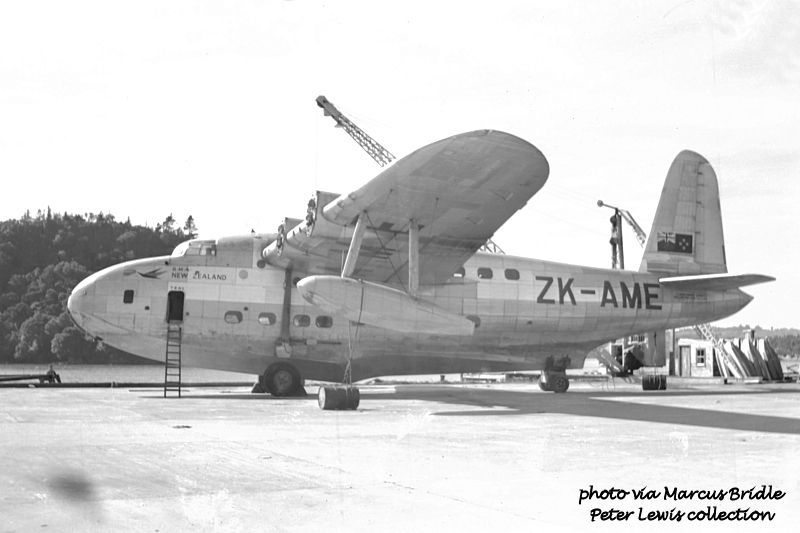 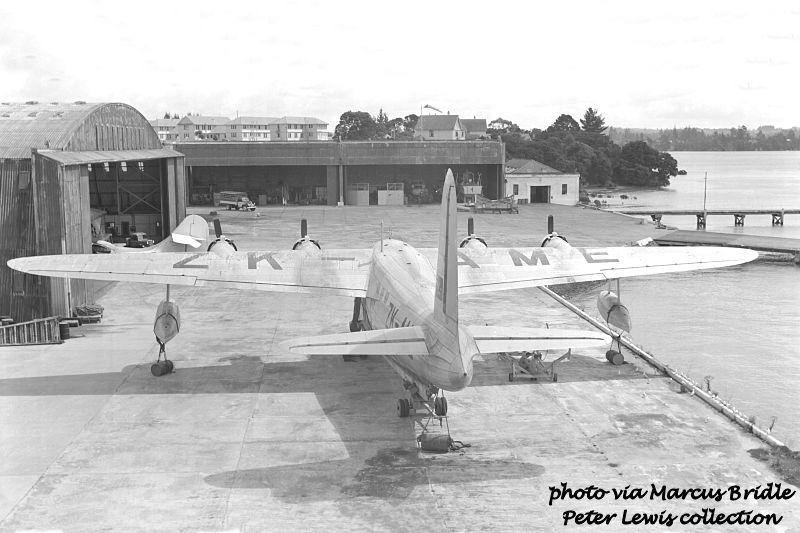 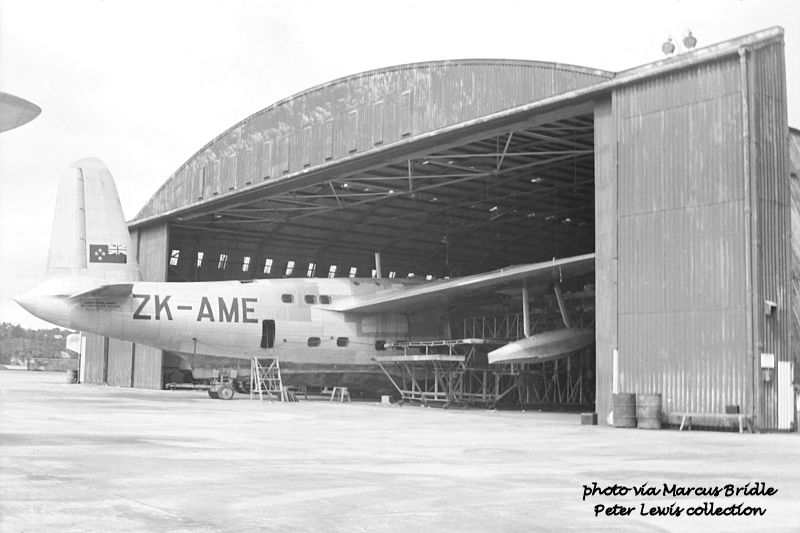 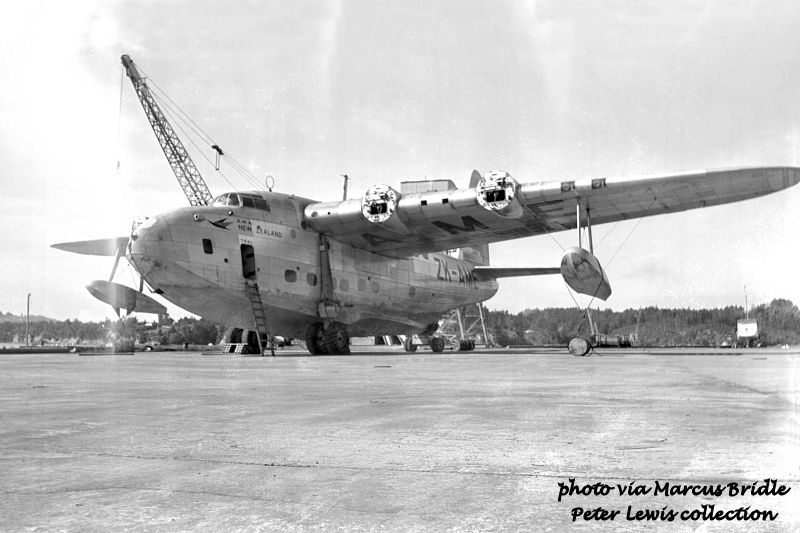 ZK-AME, ZK-AMD and Catalina ZK-AMP at Hobsonville ZK-AME, ZK-AMD and Catalina ZK-AMP at Hobsonville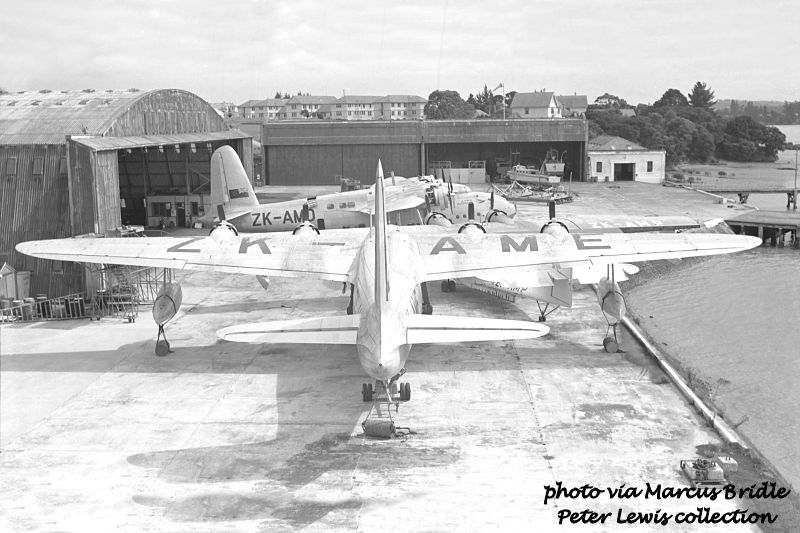  At the Mechanics Bay braby At the Mechanics Bay braby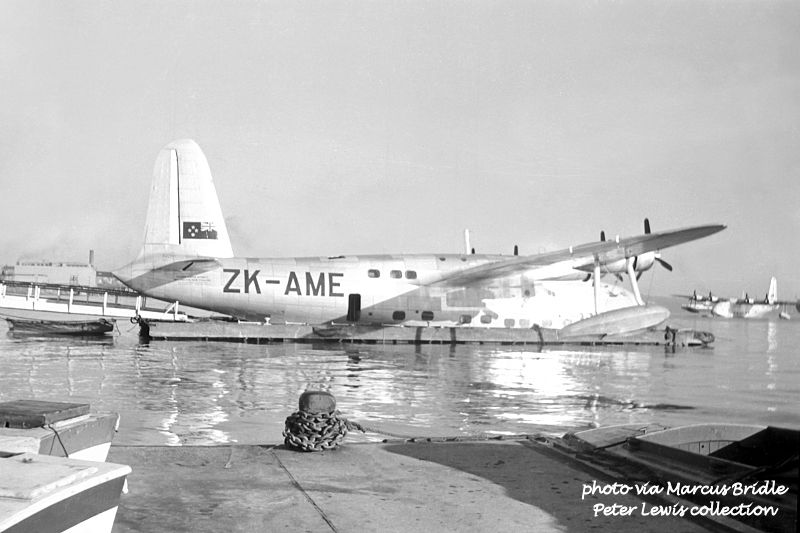 Following ZK-AME completing the final TEAL Sandringham service Sydney - Auckland on 19Dec1949 (Captain P.J. Le Couteur and Captain LH. Parry), ZK-AME was stored at Hobsonville from 19Jan1950 until sold to Barrier Reef Airways of Australia and registered as VH-BRD on 12Mar1951. Flown from Auckland to Brisbane on the 27th April, it operated with Barrier Reef as 'Capricorn' until sold to Ansett Flying Boat Services in May 1952 and was renamed 'Princess of Cairns'. The end came when it partially sank at its moorings in the Brisbane River during the night of 31Oct1952 after it was struck by an unidentified boat. Refloated, it was declared unrepairable and was sold to an entrepreneur who intended to convert it into a floating restaurant. While under tow to the Gold Coast 1Feb1954, it was swamped by waves and sank at sea. The wreckage was never located. |
|
ron
Squadron Leader
  
Posts: 111
|
Post by ron on Mar 2, 2012 17:59:19 GMT 12
Small correction. VH-BRD sank at its moorings in the Brisbane River (not Cairns) so the tow to the Gold Coast was over a comparitively short distance. There were two significant arrivals in Brisbane on 27 April 1950. ZK-AME was one and I was the other!
Rgds
|
|
|
|
Post by Peter Lewis on Mar 3, 2012 7:41:37 GMT 12
Thanks for the correction Ron.
I have amended the entry.
|
|
|
|
Post by Peter Lewis on Mar 3, 2012 7:47:46 GMT 12
As the end of the Pacific War approached, the British looked at reasserting their influence in the area. Conscious of American dominance of the wartime long range air routes, they sought to establish a foothold that could be leveraged into post-war commercial aviation. The RNZAF martime operations in the Pacific were based on lend-lease PBY Catalina flying boats. In theory, these aircraft were to be handed back to the US Navy on the conclusion of hostilities. This would leave a massive gap in RNZAF operational capability. Therefore a deal was struck where the New Zealand Government bought four new Sunderland III flying boats from the British, and would therefore be able to operate these aircraft in a transport role as and where they wished. Fitted out as military transports from new, these four Sunderlands were delivered to Oban in Scotland where New Zealand crews took over the aircraft and prepared for the delivery flight. Short S.25 Sunderland III ML792 had been built by Shorts at Rochester, shop order no.SB4665, and was bought on charge with the Air Council on 20Aug1944 arriving in Auckland at the conclusion of its delivery flight on 2Dec1944. Upon arrival at Hobsonville, ML792 was bought on charge as NZ4101, had the ferry equipment removed and was fitted out for military freight and passenger transport operations. The Flying Boat Transport Flight was formed, with maintenance and training facilities at Hobsonville and operational terminal at Mechanics Bay. The name 'Tainui' was applied to NZ4101, the name of one of the original Maori migration canoes from early New Zealand settlement. The Sunderlands of the Flying Boat Transport Flight were mainly used on Auckland-Fiji and Auckland - Noumea - Espiritu Santo routes from February 1945 until laid up at Hobsonville in October 1945 with engine/propeller problems. NZ4101 saw some use in early 1946 training TEAL crews for the about-to-arrive Sandringhams. By June that year, with camouflage removed but still carrying military markings, it was operating on the Auckland-Fiji run mostly carrying civilian fare-paying passengers. 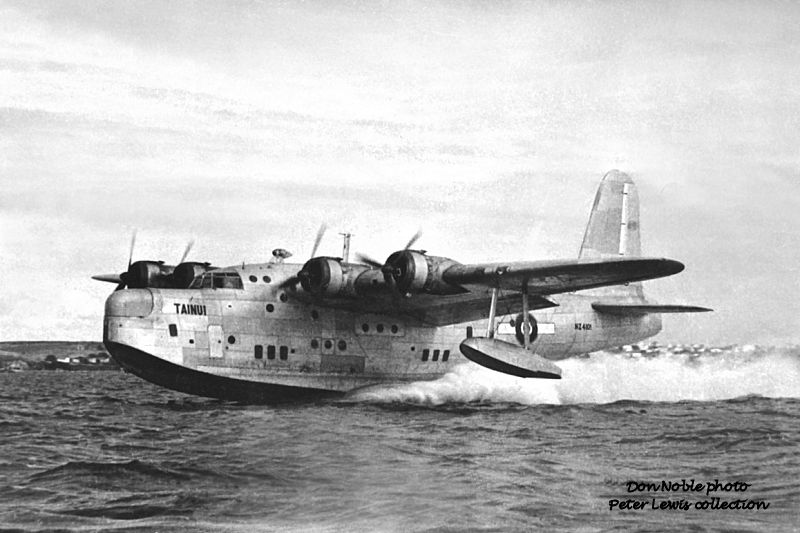 This service was legitimized in in 1947 when two of the Sunderlands adopted civil identities with the Government-owned National Airways Corporation, and NZ4101 was also transfered to NAC on 16Dec1947 as a spares source. The registration ZK-AMJ was reserved for use by NZ4101, but this was never adopted and ZK-AMJ was reallocated to another aircraft at a later time. NZ4101 stayed in reserve at Hobsonville until released back to the RNZAF in October 1949. The Air Force had no use for this aircraft, and it was sold by tender dated 10Oct1949 and was scrapped at Hobsonville in December 1949. The paperwork limped much further behind, with NZ4101 being officially taken back on charge from NAC on 14Sep1952 and struck off charge on 16Dec1957! |
|
|
|
Post by Peter Lewis on Mar 4, 2012 7:12:27 GMT 12
Short S.25 Sunderland III ML793 had been built by Shorts at Rochester, shop order no.SB46656 and was bought on charge with the Air Council on 18Sep1944. This aircraft flew to Auckland on 2Dec1944. Upon arrival at Hobsonville, ML793 was bought on charge as NZ4102 4Dec1944, had the ferry equipment removed and was fitted out for military freight and passenger transport operations. As part of the Flying Boat Transport Flight, the name 'Tokomaru' was applied to NZ4102, the name of one of the original Maori migration canoes from early New Zealand settlement. In postwar service, natural metal and RAF-type roundels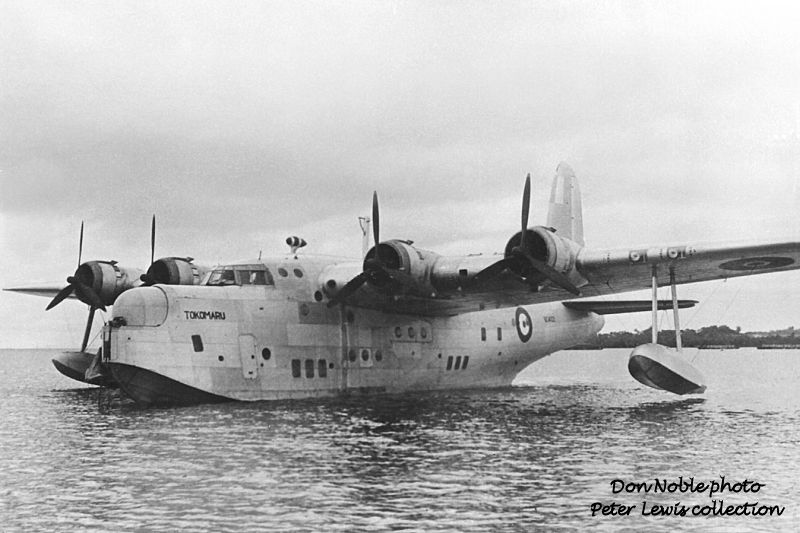 NZ4102 was employed on the Auckland - Suva and Auckland - Noumea - Espirutu Santo routes from February to October 1945. This Sunderland was then laid up at Hobsonville awaiting resolution of the engine/propeller problems that had surfaced during Pacific Service. Along with NZ4101, NZ4102 was reactivated to carry out training flights for TEAL aircrew in readiness for the arrival of the Sandringham boats later that year. By June 1946, it was in use for the RNZAF joint civil/military service on the Auckland - Fiji route, making its first trip on 6Jun1946. In order to regularize this service, NZ4102 was transferred, along with NZ4103, to the Government-owned New Zealand National Airways Corporation on 16May1947. NZ4103 had already been converted to full civilian passenger layout, and worked commenced on NZ4102 at Hobsonville for its proposed passenger role as ZK-AMF. At this point things become a little fuzzy. NZ4102 was transferred back to the RNZAF and the registration ZK-AMF cancelled on 22Dec1947. Work then proceeded on converting NZ4104 to civilian layout as ZK-AMK. I do not believe NZ4102 ever entered service as ZK-AMF, and photographs of this aircraft in later years show it still painted up in military marks as NZ4102. I have never seen a photo of it as ZK-AMF. Other flying boats that were returned to the RNZAF after civilian use were not repainted back into military colours. I assume that some problems were found with NZ4102 early in the conversion process, and it was easier to convert NZ4104 than to fix these problems on NZ4102. In any event, NZ4102 stayed at Hobsonville in reserve, and was later moved up into 'rotten row' on the grass airfield parked among the retired Catalinas. The RNZAF Catalina just beyond NZ4102 is NZ4017 XX-T, while the one behind is NZ4052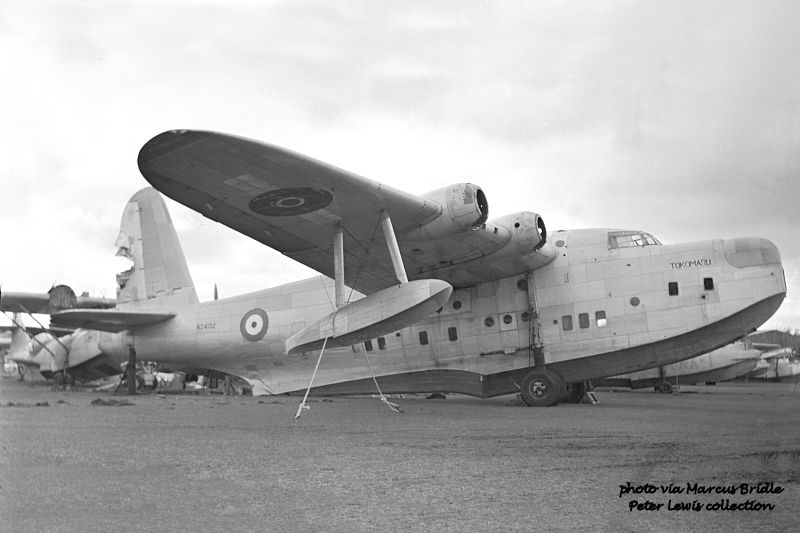 Eventually, NZ4102 was sold to the scrap merchant and cut up on site during 1955. |
|
|
|
Post by Peter Lewis on Mar 5, 2012 19:56:05 GMT 12
Short S.25 Sunderland III ML794 had been built by Shorts at Rochester, shop order no.SB46667 and was bought on charge with the Air Council on 12Sep1944. This aircraft departed RAF Mount Batten (located on Plymouth Sound, Devon) on 21Oct1944 and the aircraft finally arrived at Hobsonville on 5Dec1944. Upon arrival at Hobsonville, ML794 was bought on charge as NZ4103 4Dec1944, had the ferry equipment removed and was fitted out for military freight and passenger transport operations. As part of the Flying Boat Transport Flight, the name 'Mataatua' was applied to NZ4103, the name of one of the original Maori migration canoes from early New Zealand settlement. NZ4103 was employed on the Auckland - Suva and Auckland - Noumea - Espirutu Santo routes from February to October 1945, losing its wartime camouflage in favour of a natural metal finish after VJ day. By January 1946, civilian use for the Sunderland fleet had been identified, and conversion of NZ4103 to a 26 passenger civilian standard had started at Hobsonville. This work must have proceeded slowly, as it did not participate in the Auckland - Fiji service that operated in mid-1946. NZ4103 undertook its post-conversion test flight over Auckland on 26 Oct1946 and few days later flew to Evans Bay to operate a proving flight from Wellington to the Chatham Islands. The pilots conducting the test flights on 26 October 1946 of 1 hour 30 min and 3 hours 45 min were Flt Lt Layne and Sqdn Ldr Mackgill. Following this test, NZ4103 then re-entered service with the Flying Boat Transport Flight on their quasi-civil transport operations. On 30Sep1947, NZ4103 was transferred to the National Airways corporation, along with NZ4102, and became ZK-AMG. Already converted to full civilian standard, it was able to enter NZNAC service immediately on the Auckland - Suva - Labasa route and continued reliably in service until 30Mar1949. ZK-AMG under maintenance at Hobsonville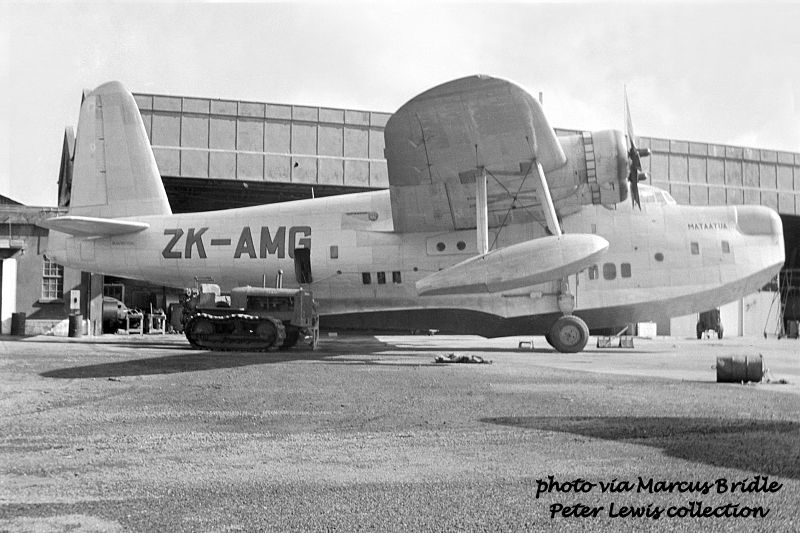 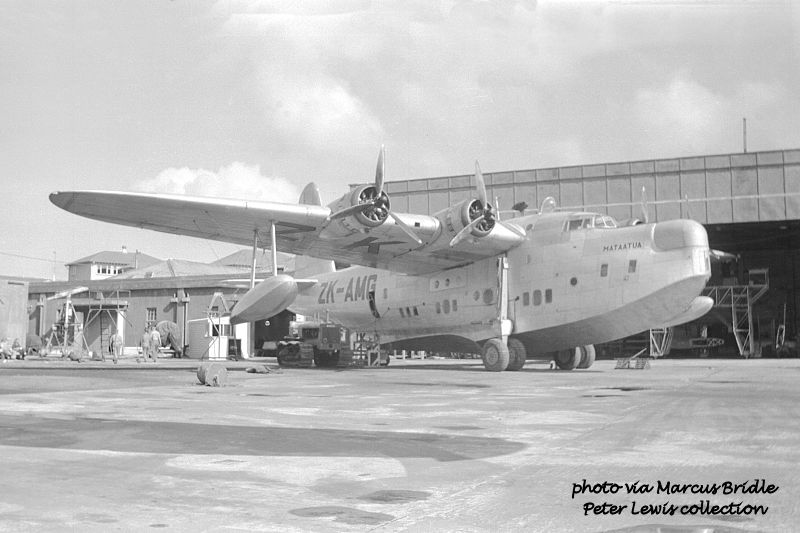 Moored out at Hobsonville Moored out at Hobsonville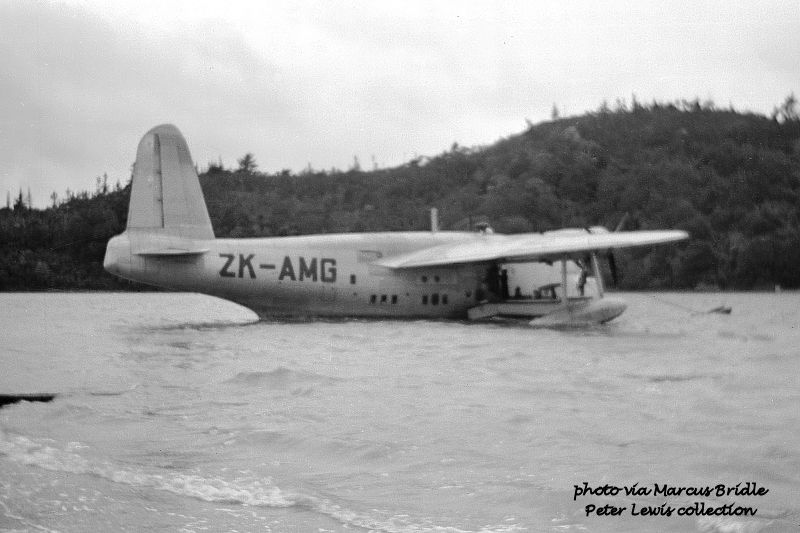 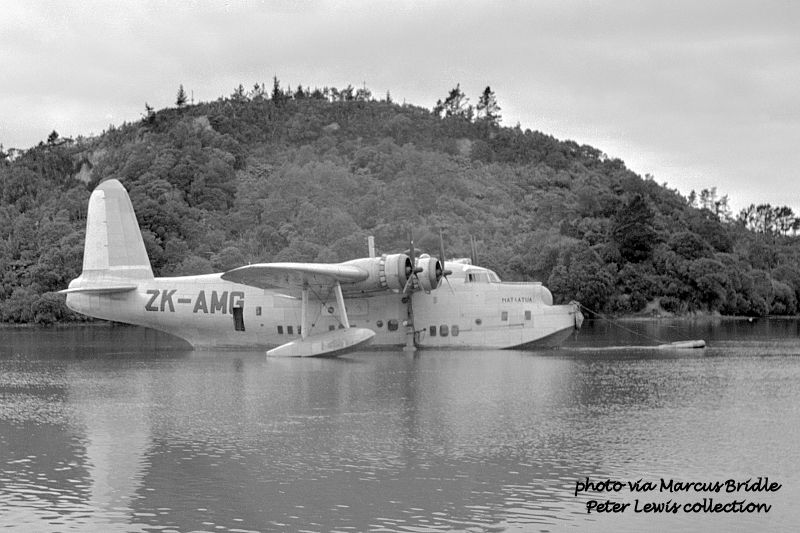 At the conclusion of NZNAC service in March 1949. ZK-AMG was returned to the RNZAF and taken back on charge as NZ4103 on 9Feb1951 - most likely a book entry in preparation for an offer of sale by tender in May 1951. In any event the aircraft remained in outside storage at Hobsonville and was re-offered for sale in late 1953 and broken up for scrap in 1954. ZK-AMG stored at Hobsonville after the RNZAF resumed ownership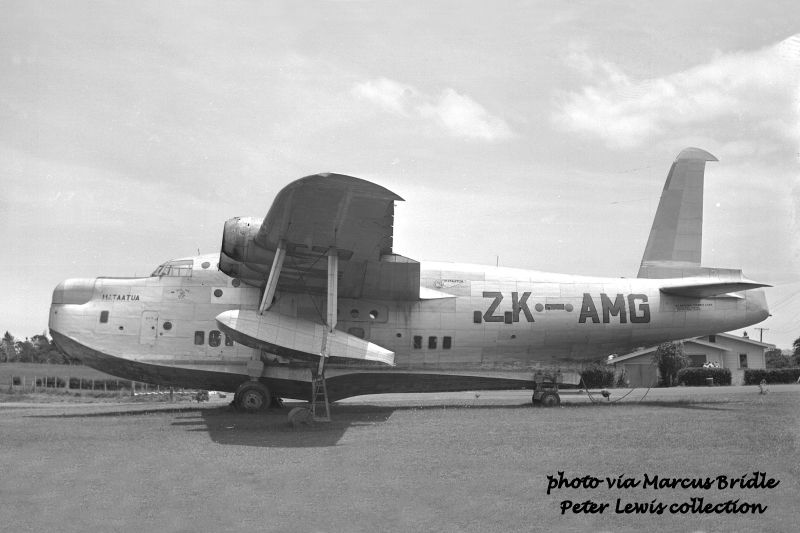 |
|



